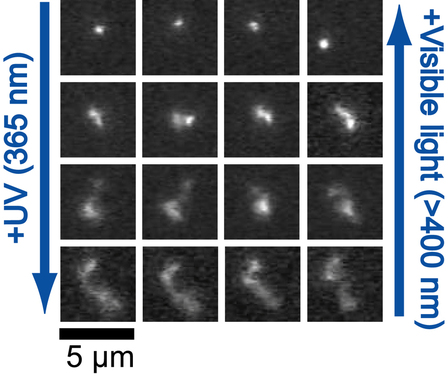Rerversible photocontrol of DNA conformation

We develop a method to reversibly control DNA conformation using light. It is based on the use of a photosensitive nucleic acd binder (pNAB), which induces DNA compaction in a photodependent manner. As a result, there is pNAB concentration for which DNA folds into compact after blue light illumination(~420-450 nm) and unfolds after UV illumination (~365 nm). Both states of DNA (compact and unfolded) are stable under dark conditions. The system is reversible and several cycles of compaction/decompaction can be done by successive blue and UV illumination.
We optimize the chemical structure of adequate pNAB candidates, combine them with other compounds such as nanoparticles to improve their efficiency, and apply this method for the reversible photocontrol of gene expression.
We optimize the chemical structure of adequate pNAB candidates, combine them with other compounds such as nanoparticles to improve their efficiency, and apply this method for the reversible photocontrol of gene expression.
Photocontrol of DNA compaction Real-time fluorescence microscopy of T4 DNA (1 µg/mL) dyed with YOYO-1 (100 nM) in transcription conditions (E. coli RNA polymerase 0.02 U/μL, tris-HCl pH 7.5 40 mM, KCl 150 mM, MgCl2 10 mM, NTPs 0.5 mM, T = 37 °C) for different AzoTAB concentrations and UV illumination conditions. Without UV, all DNA moleculeshave an elongated coil conformation ([AzoTAB] = 0 mM and 1.3 mM). DNA molecules fold into a compact state when a sufficient amount of AzoTAB is added ([AzoTAB] = 2 mM). When UV is applied on this sample, all initially compact DNA molecules unfold and recover the elongated coil conformation.
Key-publications
Photocontrol of Single-Chain DNA Conformation in Cell-Mimicking Micro-Compartments
M. Sollogoub, S. Guieu, M. Geoffroy, A. Yamada, A. Estévez-Torres, K. Yoshikawa, D. Baigl, ChemBioChem 2008, 9, 1201-1206 - doi : 10.1002/cbic.200800072 -
Our first demonstration of the photocontrol of DNA conformation at the single-molecule level, in bulk and in artificial cell systems
Photosensitive Surfactants with a Variable Hydrophobic Tail Length for the Photocontrol of Genomic DNA Conformation with Improved Efficiency
A. Diguet, N. K. Mani, M. Geoffroy, M. Sollogoub, D. Baigl, Chem. Eur. J. 2010, 16, 11890-11896 - doi : 10.1002/chem.201001579 -
Where we show that increasing hydrophobicity of a pNAB improves the ability to compact DNA but reduces the possibility of unfolding, which results in the desing of an optimized molecule offering the best compromise between DNA affinity and compaction reversibility.
Enhancement of DNA Compaction by Negatively Charged Nanoparticles. Application to Reversible Photocontrol of DNA Higher-Order Structure
S. Rudiuk, K. Yoshikawa, D. Baigl*, Soft Matter 2011, 7, 5854 - doi : 10.1039/c1sm05314k -
Where we show that the addition of anionic nanoparticles enhance the compaction efficiency of pNABs such as photosensitive surfactants
Sequence-independent and reversible photocontrol of transcription/expression systems using a photosensitive nucleic acid binder
A. Estévez-Torres, C. Crozatier, A. Diguet, T. Hara, H. Saito, K. Yoshikawa, D. Baigl, Proc. Natl. Acad. Sci. USA 2009, 106, 12219 - doi : 10.1073/pnas.0904382106 -
The first demonstration of a reversible photocontrol of gene expression based on the use of light-induced nucleic acid conformational changes and Damien's favorite paper
Photocontrol of Single-Chain DNA Conformation in Cell-Mimicking Micro-Compartments
M. Sollogoub, S. Guieu, M. Geoffroy, A. Yamada, A. Estévez-Torres, K. Yoshikawa, D. Baigl, ChemBioChem 2008, 9, 1201-1206 - doi : 10.1002/cbic.200800072 -
Our first demonstration of the photocontrol of DNA conformation at the single-molecule level, in bulk and in artificial cell systems
Photosensitive Surfactants with a Variable Hydrophobic Tail Length for the Photocontrol of Genomic DNA Conformation with Improved Efficiency
A. Diguet, N. K. Mani, M. Geoffroy, M. Sollogoub, D. Baigl, Chem. Eur. J. 2010, 16, 11890-11896 - doi : 10.1002/chem.201001579 -
Where we show that increasing hydrophobicity of a pNAB improves the ability to compact DNA but reduces the possibility of unfolding, which results in the desing of an optimized molecule offering the best compromise between DNA affinity and compaction reversibility.
Enhancement of DNA Compaction by Negatively Charged Nanoparticles. Application to Reversible Photocontrol of DNA Higher-Order Structure
S. Rudiuk, K. Yoshikawa, D. Baigl*, Soft Matter 2011, 7, 5854 - doi : 10.1039/c1sm05314k -
Where we show that the addition of anionic nanoparticles enhance the compaction efficiency of pNABs such as photosensitive surfactants
Sequence-independent and reversible photocontrol of transcription/expression systems using a photosensitive nucleic acid binder
A. Estévez-Torres, C. Crozatier, A. Diguet, T. Hara, H. Saito, K. Yoshikawa, D. Baigl, Proc. Natl. Acad. Sci. USA 2009, 106, 12219 - doi : 10.1073/pnas.0904382106 -
The first demonstration of a reversible photocontrol of gene expression based on the use of light-induced nucleic acid conformational changes and Damien's favorite paper